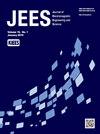厚导电屏窄槽传输模式的分类
IF 1.7
3区 工程技术
Q3 ENGINEERING, ELECTRICAL & ELECTRONIC
Journal of electromagnetic engineering and science
Pub Date : 2022-07-31
DOI:10.26866/jees.2022.4.r.117
引用次数: 0
摘要
本文研究了当平面波入射厚导体板狭槽时,电磁能量通过狭槽的传输。厚板上的槽形成波导结构。从截止频率的角度,将其传输特性分为三种模式。在截止点以上的范围内,传输腔共振(TCR)模式取决于板的厚度,峰值传输截面(TCSs)沿着板的厚度周期性地出现,称为法布里-珀罗共振。近截止共振传输(NCRT)模式取决于槽长和板厚,最大TCS仅以槽长共振(或横向共振)的形式出现一次。NCRT模式的峰值TCS发生在薄板厚度下,从而产生槽长共振。非传输腔(NTC)模式是一种非传输和非共振模式,不传播。TCR和NCRT模式的最大tcs都发生在平行共振中。分析结果表明,通过厚板槽的三种传输模式的分类可以有效地用TCS和孔径阻抗来解释。本文章由计算机程序翻译,如有差异,请以英文原文为准。
Classification of Transmission Modes through a Narrow Slot in a Thick Conducting Screen
This paper examines electromagnetic energy transmission through a narrow slot in a thick conducting plate when a plane wave is incident to the slot. The slot in the thick plate creates a waveguide structure. From the perspective of cutoff frequency, the transmission characteristics are classified into three modes. The transmission cavity resonance (TCR) mode in the range above the cutoff depends on the plate thickness, and peak transmission cross-sections (TCSs) appear periodically along the plate thickness, known as Fabry-Perot resonance. The near-cutoff resonance transmission (NCRT) mode depends on the slot length and plate thickness, and the maximum TCS appears only once as a slot length resonance (or transverse resonance). The peak TCS for the NCRT mode occurs with a thin plate thickness, which produces slot length resonance. The non-transmission cavity (NTC) mode is a non-transmission and non-resonance mode and is not propagated. All the maximum TCSs for the TCR and NCRT modes occur in parallel resonance. The analysis results show that the classification of the three transmission modes through the thick plate slot is effectively explained by the TCS and aperture impedance.
求助全文
通过发布文献求助,成功后即可免费获取论文全文。
去求助
来源期刊

Journal of electromagnetic engineering and science
ENGINEERING, ELECTRICAL & ELECTRONIC-
CiteScore
2.90
自引率
17.40%
发文量
82
审稿时长
10 weeks
期刊介绍:
The Journal of Electromagnetic Engineering and Science (JEES) is an official English-language journal of the Korean Institute of Electromagnetic and Science (KIEES). This journal was launched in 2001 and has been published quarterly since 2003. It is currently registered with the National Research Foundation of Korea and also indexed in Scopus, CrossRef and EBSCO, DOI/Crossref, Google Scholar and Web of Science Core Collection as Emerging Sources Citation Index(ESCI) Journal. The objective of JEES is to publish academic as well as industrial research results and discoveries in electromagnetic engineering and science. The particular scope of the journal includes electromagnetic field theory and its applications: High frequency components, circuits, and systems, Antennas, smart phones, and radars, Electromagnetic wave environments, Relevant industrial developments.
 求助内容:
求助内容: 应助结果提醒方式:
应助结果提醒方式:


